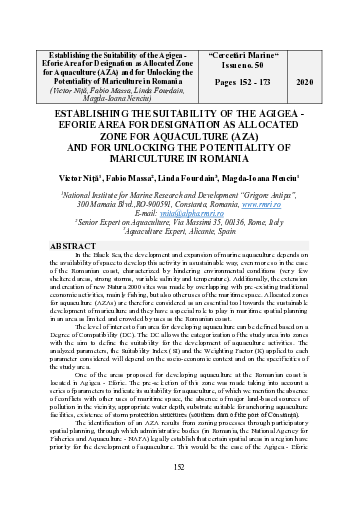Establishing the Suitability of the Agigea - Eforie Area for Designation as Allocated Zone for Aquaculture (AZA) and for Unlocking the Potentiality of Mariculture in Romania
DOI:
https://doi.org/10.55268/CM.2020.50.152Keywords:
mariculture, allocated zones for aquaculture (AZAs), parameters, Degree of Compatibility (DC), suitability, employment opportunity, marine spatial planningAbstract
In the Black Sea, the development and expansion of marine aquaculture depends on the availability of space to develop this activity in a sustainable way, even more so in the case of the Romanian coast, characterized by hindering environmental conditions (very few sheltered areas, strong storms, variable salinity and temperature). Additionally, the extension and creation of new Natura 2000 sites was made by overlapping with pre-existing traditional economic activities, mainly fishing, but also other uses of the maritime space. Allocated zones for aquaculture (AZAs) are therefore considered as an essential tool towards the sustainable development of mariculture and they have a special role to play in maritime spatial planning in an area as limited and crowded by uses as the Romanian coast. The level of interest of an area for developing aquaculture can be defined based on a Degree of Compatibility (DC). The DC allows the categorization of the study area into zones with the aim to define the suitability for the development of aquaculture activities. The analyzed parameters, the Suitability Index (SI) and the Weighting Factor (K) applied to each parameter considered will depend on the socio-economic context and on the specificities of the study area. One of the areas proposed for developing aquaculture at the Romanian coast is located in Agigea - Eforie. The pre-selection of this zone was made taking into account a series of parameters to indicate its suitability for aquaculture, of which we mention the absence of conflicts with other uses of maritime space, the absence of major land-based sources of pollution in the vicinity, appropriate water depth, substrate suitable for anchoring aquaculture facilities, existence of storm protection structures (southern dam of the port of Constanța). The identification of an AZA results from zoning processes through participatory spatial planning, through which administrative bodies (in Romania, the National Agency for Fisheries and Aquaculture - NAFA) legally establish that certain spatial areas in a region have priority for the development of aquaculture. This would be the case of the Agigea - Eforie area at the Romanian Black Sea coast, which meets all the prerequisites for developing aquaculture without causing pressure on the environment and, at the same time, being socially accepted by all users of the maritime space.
Downloads
Published
2020-12-20
How to Cite
Niță, V., Massa, F., Fourdain, L., & Nenciu, M.-I. (2020). Establishing the Suitability of the Agigea - Eforie Area for Designation as Allocated Zone for Aquaculture (AZA) and for Unlocking the Potentiality of Mariculture in Romania. Cercetări Marine - Recherches Marines, 50(1), 152–173. https://doi.org/10.55268/CM.2020.50.152
Issue
Section
ORIGINAL ARTICLES
License
This is an open access journal, which means that all content is freely available without charge to the user or his/her institution. Users are allowed to read, download, copy, distribute, print, search, or link to the full texts of the articles, or use them for any other lawful purpose, without asking prior permission from the publisher or the author. This is in accordance with the BOAI definition of open access.






